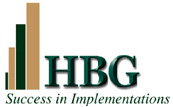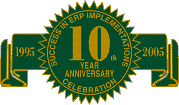Home
|
Key Components of an APS system
HBG practical and theoretical experience with Advanced Planning and Scheduling solutions suggests that your APS system, in terms of technology architecture, must have:
- ERP/Shop Floor Interface. Transmits planning and product/process definition information resident in the ERP and also uploads information to the ERP system regarding production. E.g. BOM, routers, work orders, inventory levels, WIP etc. It must also capture process control and resource status information in order to map the latest Shop Floor or Supply Chain conditions.
Most add-on APS systems offer standard interfaces for established ERP systems. However, those interfaces assume that your product and process definitions (BOM, Routers and Distribution Network) were set up to reflect and support your best manufacturing or distribution model. In most cases they were not.
Consequently, integrating an off-the-shelf APS solution into an existing ERP may be the most challenging part of your implementation.
- Production and Replenishment Rules Repository. Houses additional planning, scheduling, distribution and transportation related data (tooling, set up characteristics, distance between nodes, maximum cube, desired fill rate, buffers size, equipment variability, Takt time etc.) as well as functionality for editing data to optimize its use in scheduling.
- Distributed Scheduling Engine. It contains scheduling algorithms, optimization formulas and heuristics rules and priorities used by planners e.g. Minimize setup, forward or backward scheduling, bottleneck scheduling etc. It applies the ERP and the Rules Repository information to the mathematical models that define how the plans and schedules will be calculated. Also contains the ability to apply manual changes to a calculated schedule, giving the planner the required flexibility in finalizing the schedule.
The engine must also be re-configurable as new algorithms and heuristics rules become a requirement in your business.
- Simulation Modeling. Changes in Shop Floor or Supply Chain conditions (such as breakdowns and other unexpected interruptions) need to be simulated in order to assess schedule execution risk. The simulation model runs in tandem with the schedule and does not necessarily replaces it.
This modular view of the plant or distribution network must aggregate machines, cells and distribution nodes that have their own operating rules and scheduling constraints into an integrated schedule of the whole plant or network, so that "what-if" scenarios can be tested at various levels.
- Graphical User Interface. A suitable and familiar interface for planners and schedulers (such as a planning board) to efficiently interact with the APS system in order to edit results, manually affect changes and communicate to others the schedule sequence.
- Operating Mode.
- Standalone.
- Client Server.
- Web Enabled.
- Fully Distributed (multiple APS systems synchronized across the enterprise).
- B2B coupling (multiple APS systems synchronized across the Supply Chain).
- Any combinations of the above.
|
|

